Understanding Liquid Force in Kiteboarding
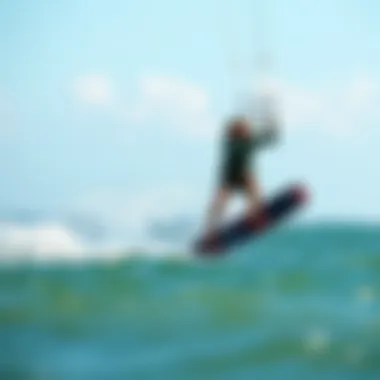
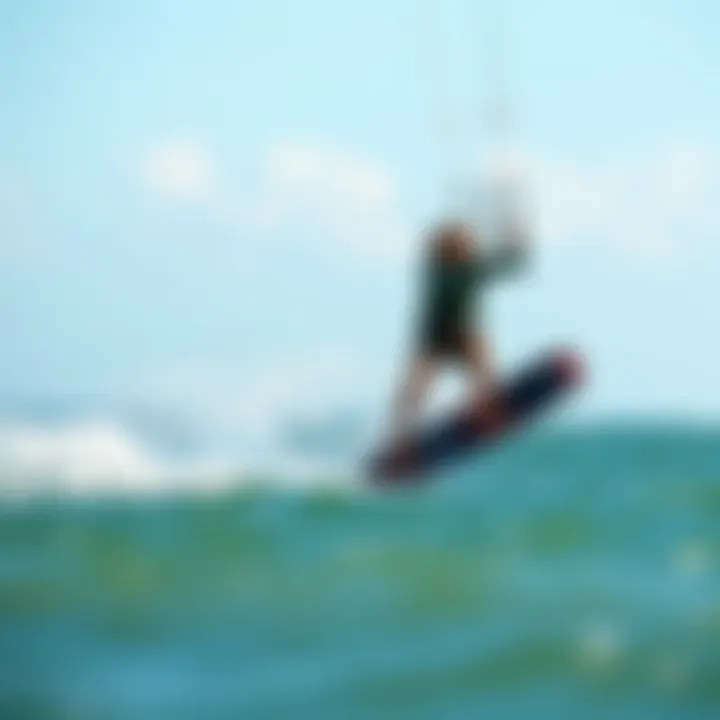
Intro
Kiteboarding is not just a thrilling outdoor activity; it’s a fascinating dance between human skill and the elements. At the heart of this dance lies the concept of liquid force, an essential player in how kiteboarders interact with water. Understanding this force can significantly impact performance and safety in the sport. As kiteboarders glide across the water, they are not merely riding a board; they are manipulating forces—both tangible and intangible—that influence speed, control, and the overall experience on the water.
The phenomenon of liquid force is intricately tied to the physics of water dynamics, and it manifests in various ways as a kiteboarder navigates the waves and wind. This article is dedicated to unraveling the intricacies of liquid force, guiding both beginners and veteran riders on how to harness this force for an enhanced kiteboarding journey.
Gear and Equipment
When it comes to kiteboarding, having the right gear can make all the difference. Understanding how liquid force interacts with different equipment empowers riders to make informed choices, enhancing their overall experience.
Essential Kiteboarding Gear for Beginners
For those just dipping their toes into the kiteboarding world, investing in essential gear is crucial. A properly chosen setup can help beginners learn the ropes while minimizing risks. Here’s a list of must-haves:
- Kite: Start with a beginner-friendly kite, typically larger in size, to ensure better lift and stability in the air.
- Board: Look for a twin-tip board that offers versatility in riding direction. This style is forgiving for newbies, allowing them to explore various maneuvers.
- Harness: A comfortable harness is necessary for allowing the kite's force to pull you without straining your arms.
- Safety Leash: Always include a safety harness or leash to ensure you can quickly detach from the kite when needed.
- Helmet and Impact Vest: Safety gear is essential—investing in a helmet and an impact vest can protect against falls and collisions.
Advanced Equipment for Experienced Riders
As skills progress, so does the need for specialized gear to push performance. Here are some recommended pieces for seasoned kiteboarders:
- High-Performance Kite: Advanced kites are designed for speed and control, often made from lighter materials for better responsiveness.
- Surfboard or Directional Board: Experienced riders might appreciate the precision offered by a directional board, especially in wave riding conditions.
- Foil Board: For those looking to explore the next level, foil boards allow for an entirely new riding experience over the water.
- Custom Harness: More experienced riders often prefer a harness tailored to their specific riding style and preferences for ultimate comfort.
Adapting gear to fit one's skill and style allows for better control over liquid force, enhancing overall performance on the water.
Techniques and Tips
Navigating through the waves doesn’t solely depend on equipment; techniques play a crucial role. Understanding how to counteract and leverage liquid force can elevate one’s kiteboarding skills.
Basic Riding Techniques for Newbies
For those still finding their balance, here are basic techniques to keep in mind:
- Body Positioning: Maintain a low center of gravity for stability. Bend your knees slightly and keep your weight centered over the board.
- Edge Control: Learn to control the board’s edge in the water, which helps you maneuver effectively without losing speed.
- Depower the Kite: Understand how to depower the kite in stronger winds. Pulling on the back lines directs the kite less into the wind, decreasing its pull.
Expert Tricks to Elevate Your Skills
As you gain confidence, consider these expert techniques:
- Jumping: Use the power of the kite to launch into the air. Timing is essential; initiate the jump by edge-to-edge transition and pulling on the kite slightly upwards.
- Tricks: Once comfortable airborne, try spins or grabs to improve your aerial skills and impress those watching.
- Waves Riding: If you're at a spot with waves, engage them to ride surf-style, manipulating the liquid force for speed and agility.
The mastery of these techniques will not only enhance your confidence but also allow you to safely explore the full range of what kiteboarding offers.
In summary, understanding the role of liquid force helps kiteboarders of all levels navigate their experience on the water more effectively. By combining knowledge of equipment with specific riding techniques, enthusiasts can improve performance while ensuring safety. Engage with the power of liquid force, and you’ll find yourself enjoying every exhilarating moment spent kiteboarding.
Learn more about kiteboarding equipment here. For advanced techniques, visit this community. Check out safety tips from the Kiteboarding Association.
Prologue to Liquid Force
Understanding liquid force is crucial for kiteboarders, both newcomers and seasoned riders alike. At its core, liquid force represents the interaction between water dynamics and the equipment used in kiteboarding. This concept is not just a theoretical idea but a practical guide that influences performance, safety, and enjoyment on the water. Riders embracing the nuances of liquid force can find themselves more adept at navigating challenges and improving their skills.
Liquid force helps kiteboarders appreciate how their movements and choices impact both their ride and safety. It involves recognizing how the kite interacts with the water’s surface and how the wind adds its unique flavor. Riders who grasp these principles can significantly enhance their overall kiteboarding experience, as they learn to harness the force of water effectively.
Moreover, engaging with the science of liquid force broadens kiteboarders’ knowledge, allowing them to adapt to varying conditions and improve their maneuverability. It's not merely a matter of riding; it’s about mastering one's interaction with the water, the winds, and even the board. With each wave, tide, or gust, the way liquid force reveals its influence draws out new techniques and modifications that riders adapt to optimize their performance.
"The ocean stirs the heart, inspires the imagination, and brings eternal joy to the soul."
In essence, this exploration of liquid force will pave the way for kiteboarders to not only understand but also effectively respond to their environment. The benefits extend beyond skill improvements and touch on safety considerations that can mean the difference between a thrilling adventure and a dangerous mishap. With this foundation, let’s delve deeper into what precisely liquid force entails.
Defining Liquid Force
Liquid force can be defined as the measurable effect of water’s resistance and support on a moving object, such as a kiteboarder traversing the water's surface. This force is a combination of several physical principles, including drag, lift, and buoyancy, which interact with the rider's actions and the equipment utilized.


When a rider skims the water, they are actively engaging with the liquid dynamics surrounding them. The force exerted by the water provides both resistance and lift, which are critical in determining a rider's speed and agility. Understanding how these forces work together can help kiteboarders refine their maneuvers and maximize their performance on the water.
Moreover, liquid force is nuanced by the conditions present. Flat water allows for different interactions compared to choppy or turbulent surfaces, making it essential for riders to adjust their technique based on environmental factors.
Historical Context in Water Sports
Historically, the study and application of liquid force in water sports reveal an evolution of techniques and equipment that have led to the modern kiteboarding experience. Water sports have roots that go back centuries, where ancient civilizations relied on sailing and surfing to navigate and ride the ocean waves. With time, as materials and technology advanced, so too did the craft of engaging with liquid forces.
In the late 20th century, kiteboarding began to take shape, inspired by both surfing and hang gliding. As this sport grew, practitioners started to apply principles of physics more concretely to their practice. Innovations in design helped to harness liquid force in more efficient ways, leading to better performance, safety features, and an overall thrilling experience on the water.
The fusion of engineering and water dynamics has allowed kiteboarders to push boundaries. Riders now experiment with different kite sizes, board types, and shapes, all to better understand and work with liquid forces in ways that older sports could only dream of. This history shapes what kiteboarding is today, with liquid force being a central theme that weaves together technique, innovation, and safety.
The Physics of Liquid Force
Understanding the physics behind liquid force is essential for kiteboarders of all skill levels. This section digs deep into the fundamental principles governing water dynamics, shedding light on how these principles can enhance performance and ensure safety on the water. Grasping the nuances of liquid force allows riders to harness the power of the water efficiently, ultimately translating into better handling, speed, and maneuverability.
Basic Principles of Fluid Dynamics
Fluid dynamics, at its core, deals with the behavior of liquids in motion. Several principles govern how water interacts with objects, and kiteboarders need to be acutely aware of these principles.
One crucial element is the continuity equation, which states that as fluid flows through a constricted path, its speed increases. Kiteboarders can exploit this principle by navigating through narrower channels or areas where water is moving more swiftly. This understanding can lead to an edge in speed and fewer energy expenditures.
Another principle worth mentioning is Bernoulli’s principle, which posits that an increase in the speed of fluid occurs simultaneously with a decrease in pressure. In kiteboarding, when the kite moves through the air, it creates a zone of low pressure above it, lifting the rider off the water. Understanding this dynamic helps riders make informed choices about their kites and maneuvers, ensuring they can adapt to varying wind conditions with ease.
How Liquid Force Affects Movement
Liquid force is not merely a background player in kiteboarding; it shapes the entire experience. Several aspects contribute to how this force influences rider movements, particularly in terms of drag and lift as well as buoyancy effects.
Drag and Lift
Drag and lift are two sides of the same coin when it comes to navigating water. Drag refers to the resistance an object encounters when moving through a fluid. For kiteboarders, managing drag is vital for maintaining speed and reducing energy loss.
An important characteristic of drag is its direct relationship with speed; as the kiteboarder accelerates, drag increases. This makes it crucial for riders to find a balance between speed and control. Riders skilled in reading the water can position their boards to minimize drag, making their experience smoother and more thrilling.
Conversely, lift occurs when fluid pressure differentials act on the kite or board. This is particularly beneficial for jumps and tricks. The lift generated by a well-angled kite can provide the extra altitude necessary for aerial maneuvers, giving the rider that extra push during stunts or speed runs.
Buoyancy Effects
The buoyancy effect is a unique feature that fundamentally alters a kiteboarder’s experience on the water. Essentially, buoyancy is the upward force exerted by the water, allowing riders to float rather than sink. This characteristic is framed by Archimedes' principle, stating that the upward buoyant force experienced by an object submerged in fluid is equal to the weight of the fluid displaced.
What makes buoyancy critical for kiteboarding is its role in stability and control. When a rider jumps or cuts through waves, the buoyancy allows them to remain on the board, effectively translating weight distribution to maintain balance. This characteristic highlights the importance of board design, as boards with the right dimensions and shape can enhance buoyancy, making them easier to maneuver, especially in challenging conditions.
In summary, the physics of liquid force, especially principles like drag, lift, and buoyancy, underline practical techniques that can markedly improve performance. Mastering these dynamics not only promotes safety but also helps riders achieve new heights in their kiteboarding journey.
Recognizing Liquid Force in Kiteboarding
In the world of kiteboarding, understanding and recognizing liquid force becomes essential for ensuring both optimal performance and rider safety. The fluid dynamics at play affect not only how a kite operates but also how a rider interacts with the water beneath. With such a profound connection, acknowledging these forces and conditions can dramatically improve the overall kiteboarding experience.
Interpreting Water Conditions
Flat Water vs. Choppy Conditions
When it comes to the differences between flat water and choppy conditions, the effects on kiteboarding are significant. Flat water, often found in lakes or calm bays, creates a predictable environment where any water sport enthusiast can hone their skills without excess distractions. Riders can easily control their speed and maneuvers here, providing ample opportunity to understand their equipment and techniques.
The key characteristic of flat water is its smooth surface, which reduces drag and allows for more straightforward transitions during tricks. Riders often find they can achieve better speed and lift in these conditions, making it a popular training ground. One unique feature of flat water is the ability to perform precise jumps and tricks without the interruptions of waves and water chop. However, the downside is that it may lack the excitement and challenge that comes with more dynamic conditions.
On the flip side, choppy water brings a whole different ball game. While it can be a challenge, it also forces riders to adapt quickly, developing more sophisticated skills over time. The undulating surface presents more significant resistance, making it necessary for riders to master edging and pressure control to maintain stability on their boards.
Though choppy conditions can be intimidating, they offer great versatility in practice. One of the most significant advantages is that riders can experience a variety of challenges that prepare them for conditions they might encounter elsewhere. This experience is invaluable, as each wave can demand unique adjustments to a kite's position or the rider's stance.
Tides and Currents
The understanding of tides and currents is another critical element in the kiteboarding landscape. These forces shift with the lunar cycle and can dramatically impact water levels, creating distinctive environments that are essential for various kiteboarding practices. The tide's influence on water depth can affect the type of riding experience one will have; for example, low tides might expose sandbars, creating interesting obstacles or ramps.
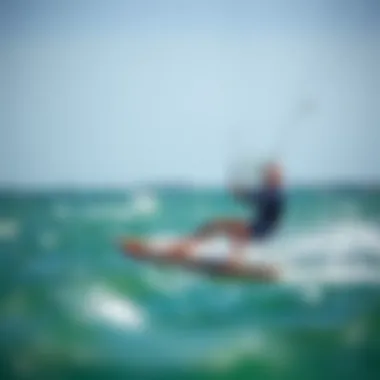
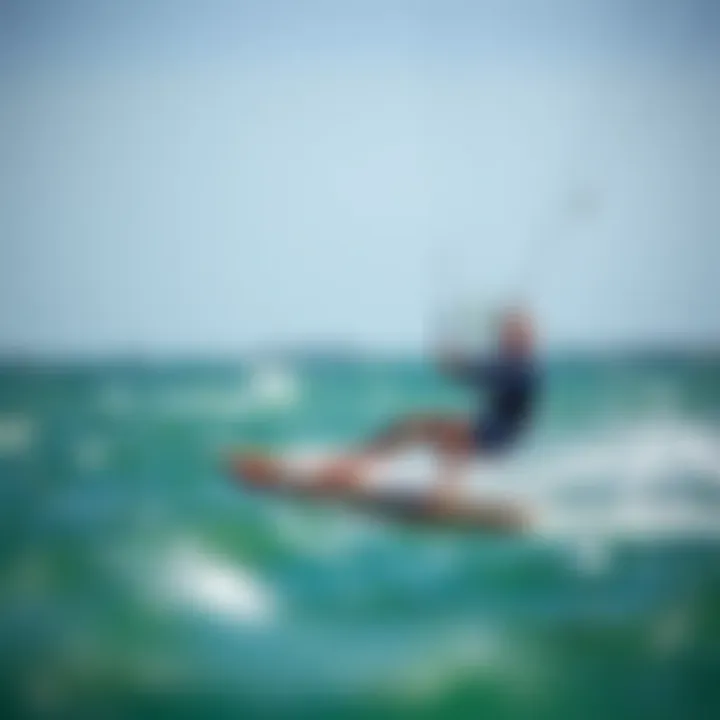
A key characteristic of tides is their patterns—predictable yet variable based on the location. By using this knowledge, kiteboarders can time their sessions to maximize their performance. For instance, riding during an incoming tide can lead to a smoother flow of water, helping to enhance speed and overall maneuverability.
On the downside, currents can pose substantial challenges. A strong current can yank any rider off course, making it essential for those venturing into such conditions to be familiar with their surroundings and potential escape routes. That’s particularly important in areas where strong currents create dangerous rip zones. A good understanding of tide behaviors will not only benefit kiteboarders in improving their skills but also enhance safety during their sessions.
Understanding water conditions is not just about performance; it's about ensuring every session is a safe one. Recognizing how tides and water surfaces change can make all the difference between a good day out and a potential mishap.
Impact on Kite Performance
The liquid force experienced in kiteboarding profoundly influences kite performance. Factors such as water smoothness, depth, and current strength all play a part in how well a kite performs during a session. A kiteboarder needs to adapt their techniques and expectations according to the conditions they encounter.
In choppy waters or strong currents, for example, the kite might need to be kept at a different angle to maintain lift. Riders who can perceive these nuances instinctively enhance their performance, increasing both enjoyment and skill level. Additionally, understanding how the liquid forces interact with their equipment allows riders to optimize their gear settings.
Ultimately, the power of liquid force is not just a foundational principle; it's a dynamic aspect of the kiteboarding experience that intertwines performance with safety. Recognizing and adapting to these conditions can elevate an average session into a memorable one.
Skill Level Adjustments for Liquid Force Mechanics
When it comes to kiteboarding, understanding the nuances of liquid force is not merely a complex topic; it’s a pivotal factor dictating how well a rider can perform on the water. The adjustments one makes according to their skill level are essential in harnessing the power of the liquid force effectively. For beginners, this might mean focusing on basic techniques, while intermediate and advanced riders delve into more sophisticated maneuvers. Each skill level necessitates a tailored approach to ensure not only safety but also the enjoyment of the sport.
Beginners' Strategies
Understanding Your Board
At the beginner level, knowing your board is essential. Your board serves as your primary tool for navigating the water, catching air, and executing turns. Key characteristics of a beginner's board include a wider base, which offers greater stability during transitions and enhances balancing skills. This stability is especially beneficial for newcomers still getting acquainted with the feel of pulling on the lines and managing their body posture while riding.
One unique feature of these boards is often the inclusion of larger fins, which increase grip on the water and help counteract unwanted drift. This can be a double-edged sword; while it helps stabilize beginning riders, it might limit some advanced maneuvers where tighter turns are required. Choosing the right board is thus a critical first step in mastering liquid force mechanics effectively. The benefits of selecting an appropriate board can make or break initial kiteboarding experiences.
Basic Maneuvers in Liquid Force
As a novice, basic maneuvers are crucial for developing a solid foundation. Simple moves such as downwind riding or edging allow beginners to understand the relationship between their speed and the force of the water. Mastering these basic maneuvers not only enhances a rider's confidence but also sets the groundwork for more advanced techniques down the line.
The key characteristic of these maneuvers is their simplicity, demanding minimal risk but maximum learning potential. However, the uniqueness of basic maneuvers lies in how they adapt to the varying liquid forces encountered. Learning to edge appropriately or to handle the front foot pressure can be challenging, but these are indispensable skills. While the advantage is the ease of learning, the disadvantage may arise when riders become reliant on these basic techniques and struggle to progress beyond them.
Intermediate Techniques
Mastering Edging and Pressure Control
For those transitioning into intermediate levels, edging and pressure control become crucial elements of the riding experience. Learning to differentiate between the pressure exerted on the board when edging allows riders to manipulate the effects of water and wind effectively. This control is vital in navigating choppy waters or ensuring smooth turns while maximizing speed.
A noteworthy attribute of this phase is the fine balance between speed and control that riders need to achieve. Riders who master this feature often find it advantageous in terms of performance but may struggle to maintain stability at higher speeds initially. With practice and increased attentiveness to how pressure affects their ride, they can harness these forces efficiently.
Working with Wind Patterns
As skills develop, the ability to read and work with wind patterns comes into play. Understanding how the wind interacts with the water surface directly influences a rider’s performance. Riders who grasp wind shifts can adjust their position and technique to take advantage of new gusts, which can translate into smoother rides and dynamic jumps.
This characteristic of utilizing natural elements makes kiteboarding an engaging sport that requires constant learning. While the ability to work with wind patterns can provide significant advantages, it does come with the challenge of requiring keen observation and timing. Those who succeed typically see an improvement in their overall maneuvers, while those who neglect this aspect risk encountering difficulties during their runs.
Advanced Execution
High-Performance Turns
Moving into advanced executing techniques, high-performance turns are often a standout feature of skilled kiteboarding. These turns capitalize on the liquid force and allow for seamless transitions, effectively harnessing momentum while reducing drag. A key characteristic of high-performance turns is the sharpness and quick execution combined with a keen eye for water conditions.
One unique feature is the ability to perform these turns without losing speed, sometimes resulting in fluidity that leaves spectators in awe. While they elevate a rider's performance through sharp and efficient maneuvers, the downside can be the risk of over-rotation or mishandling. This necessitates a balance between assertive steering and controlled braking, making practice crucial.
Using Liquid Force for Freestyling
Lastly, the application of liquid force in freestyling draws upon advanced techniques to create captivating aerial tricks. This approach involves creatively using the force of the water to lift off the surface, performing spins, flips, or grabs mid-air. The key characteristic here is the integration of technique, timing, and fluid dynamics; experienced riders can manipulate it to their advantage.
A unique aspect of this execution is the dramatic increase in skill required—the finer the movements, the more control over the board is needed. The potential for performance is vast, yet beginners or intermediate riders might find themselves overwhelmed if they attempt these maneuvers too soon. Striking the right balance between challenge and skill acquisition can often define one’s success in this exhilarating aspect of kiteboarding.
"Understanding liquid force can mean the difference between a safe ride and a risky venture. Tailoring your skills is not just smart; it’s essential for long-lasting enjoyment."
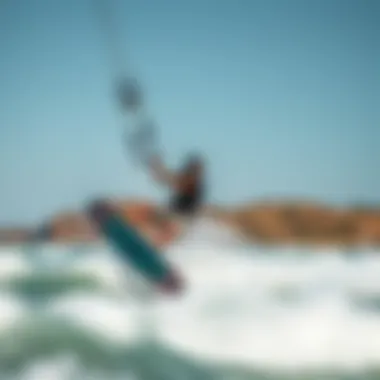
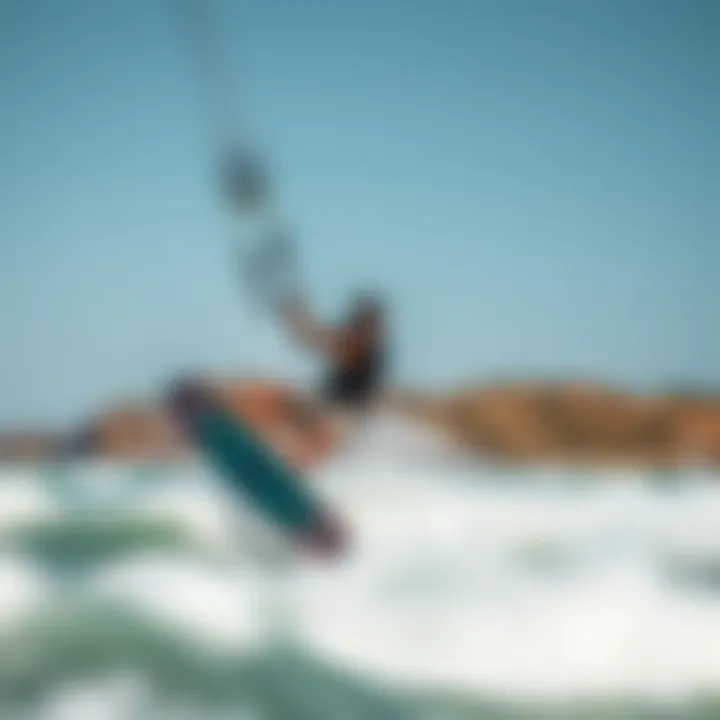
Navigating through these stages, kiteboarders steadily refine their understanding of liquid force and its mechanics. Each adjustment and technique contributes significantly to the overall performance and safety, paving the way for a fulfilling kiteboarding experience.
Safety Considerations in Liquid Force Context
When engaging in the dynamic sport of kiteboarding, emphasizing safety cannot be overstressed. Understanding liquid force not only enhances performance but also significantly influences safety practices. Riders must be aware of the conditions that may pose risks, as the intertwining of water dynamics and weather patterns can create challenging scenarios. This section dissects key elements that every kiteboarder should consider to ensure a safe and enjoyable experience.
Recognizing Dangerous Conditions
Understanding Rip Currents
Rip currents are fast, narrow channels of water that flow seaward from the shore. They often catch inexperienced kiteboarders off guard and can be a recipe for disaster. One key characteristic of rip currents is their ability to pull a rider out to deeper waters quickly. This not only endangers the individual but can also complicate rescue efforts when others are involved.
Being aware of the signs, such as breaking waves, differences in water color, or foamy water, can save a life. For kiteboarders, it’s prudent to familiarize themselves with local conditions and to seek out guidance from experienced riders or surf schools about typical rip patterns in the area. Feeling disoriented or suddenly far from the shore is a clear indication of a rip current.
- Advantages: Awareness of rip currents can help kiteboarders assess if conditions are safe before heading out.
- Disadvantages: Ignoring signs of rip currents can lead to panic and dangerous situations, affecting both the individual and those around them.
Weather Patterns and Liquid Force
Weather conditions heavily influence liquid force dynamics. Wind speed, direction, and temperature play a critical role in determining whether it's safe to kiteboard. Sudden changes in weather can lead to unpredictable wind patterns and rapidly shifting water conditions that could jeopardize safety.
For example, an unexpected storm can not only drop a temperature but also stir up the water, increasing the risk of choppy conditions and dangerous waves. Riders need to check weather forecasts regularly and be prepared to adapt their plans accordingly. Also, understanding how different weather patterns affect the ocean can help kiteboarders anticipate potential hazards.
- Advantages: A solid grasp of how weather patterns affect riding conditions can lead to better safety decisions and improved performance.
- Disadvantages: Misreading forecasts or failing to account for quick weather changes can put inexperienced riders in perilous situations.
Emergency Protocols
Proactive emergency protocols are essential for all kiteboarders. Understanding what to do in case of a sudden mishap is as crucial as knowing how to perform tricks or maneuvers.
- Carrying a personal flotation device (PFD) can be a lifesaver. In the event of strong winds or uneventful mishaps, being properly outfitted can prevent drowning and enhance safety.
- Having a partner or riding alongside others can ensure that help is on hand if something goes awry. It’s advisable to communicate clear signals for emergencies and to establish a secure meeting point.
- Familiarization with local emergency services can expedite rescue in dire situations. Knowing who to call and the location of the nearest aid ensures a quicker response.
In summary, understanding and adapting to liquid force in kiteboarding is more than just about enjoying the thrill of riding the waves. Riders must navigate their safety proactively by recognizing dangerous conditions, staying alert to weather changes, and preparing emergency protocols. This vigilance not only preserves individual well-being but also contributes to a safer community for everyone involved in the sport.
"Safety first means safety always." - Anonymous
For more information on safety practices, check local resources such as US Coast Guard, and regional kiteboarding associations like Kitesurfing Association.
The Future of Liquid Force in Kiteboarding
As kiteboarding evolves, the role of liquid force becomes increasingly paramount. Understanding how innovations in design and technique shape the waters we ride on can dramatically influence performance and safety. The future of liquid force in kiteboarding is not just about enhancing speed or style; it's also about redefining how riders interact with the very elements that propel them forward.
In recent years, we have seen a surge in technological advancements that adapt to varying water conditions. These innovations are essential for kiteboarders who venture into diverse environments, from bustling beaches with frenzied activity to secluded spots with gentle waves. Kiteboarding's evolution cannot be overstated; it’s as if we are on the cusp of a revolution of sorts.
Innovative Technologies in Kite Design
The introduction of advanced materials and streamlined designs signifies a shift in how kites harness the liquid force. Today's kites are engineered with specialized fabrics that significantly boost aerodynamics while reducing drag. For instance, brands like Duotone and Cabrinha have pioneered a range of kites featuring a new class of materials that are both lighter and more robust. The development of inflatable leading edges offers better stability while riding through varying water conditions, shedding past limitations of traditional kite designs.
Additionally, automation and artificial intelligence are making their way into kiteboarding. Kites now can adjust their trim dynamically based on wind pressure and conditions automatically. Such adaptations let riders maintain optimal performance without constantly fiddling with their setups, allowing for a more fluid experience. Imagine being able to ride smoothly without continually adjusting your kite or being distracted by equipment malfunctions amidst nature's dynamic environment.
"In the world of kiteboarding, agility and responsiveness are the names of the game. The new wave of technology promises to enhance not just speed but safety."
Evolving Techniques and Styles
With the new wave of kite technology comes fresh techniques that reflect the blend of technology and insightful riding. Riders are now encouraged to think outside the box. This doesn't mean simply improving upon existing maneuvers. It’s about reshaping how we interact with the water and wind. An advanced understanding of liquid dynamics leads to creative techniques that weren’t previously conceivable.
For example, the use of hydrofoils has opened up a previously untapped realm of kiteboarding. Hydrofoiling allows for an almost surreal sensation of riding above the water surface, significantly reducing drag. This technique transforms how riders perceive speed and motion on liquid force. Understanding how to manipulate this new phenomenon leads to exciting new styles, from jumping much higher than traditional methods permit to carving into the wind while becoming airborne, seemingly defying gravity.
The End
Summary of Key Points
Throughout this article, we have explored several crucial aspects of liquid force in kiteboarding:
- Definition and Historical Context: Liquid force is defined as the force exerted by water when a rider interacts with it while kiteboarding. Understanding its origins gives riders insight into how far this sport has come.
- Physics of Liquid Force: Familiarity with fluid dynamics allows riders to predict how water will react under various conditions, directly affecting their control and speed.
- Skill Level Adjustments: Riders of all levels have different strategies for applying knowledge of liquid force. From beginners focusing on stability to advanced riders who utilize liquid force for high-performance turns, each phase demands a unique approach.
- Safety Considerations: Recognizing dangerous water conditions and having emergency protocols can mean the difference between an exhilarating ride and an unfortunate incident.
- Future Innovations: Advancements in kite design and evolving riding techniques are paving the way for improved performance, showing that the landscape of kiteboarding is constantly changing.
Encouraging Continued Exploration
The nature of liquid force serves as a gateway to a deeper understanding of kiteboarding. It’s important for riders to keep seeking knowledge and honing their skills. Engage with community forums like Reddit to share experiences and learn from others. Attending kiteboarding workshops or participating in local meet-ups can foster not only skill enhancement but also build camaraderie among enthusiasts.
Keep experimenting with different water conditions, kite types, and riding styles. Apply the insights gained here in real-world situations for practical experience. As you venture into various terrains, observe how liquid force acts under different conditions, noting your reactions and adjustments.















